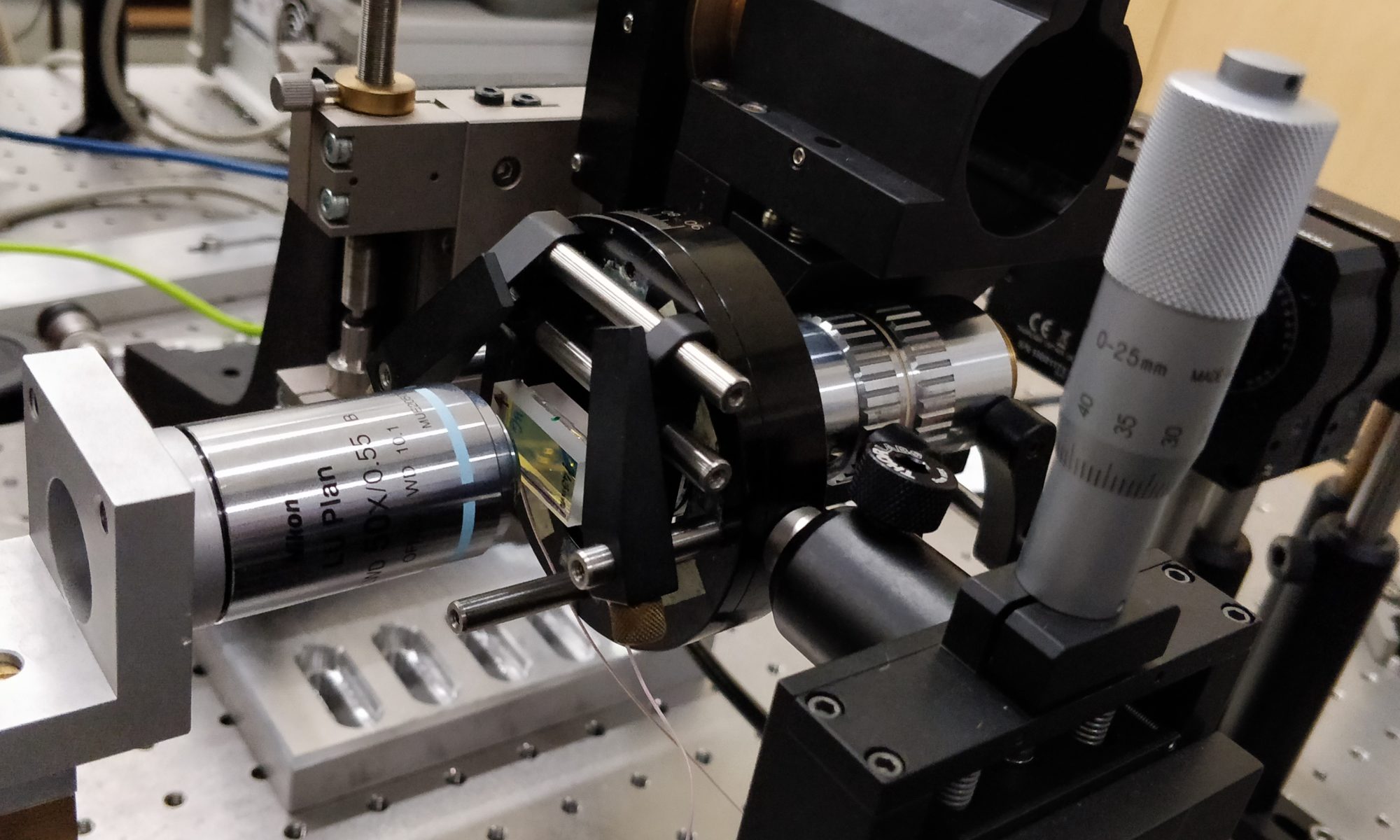![]()
Exciton-polaritons in semiconductor microcavities are widely studied systems in recent years. This is due to the observation of interesting phenomena, such as Bose-Einstein condensation, polariton laser, or superfluidity. Exciton-polaritons are quasiparticles created by the coupling of the cavity photons (light) and excitons (matter) which inherit special properties from both of their components. In particular, they have a small effective mass, which allows them to be localized in potential traps of the order of micrometers. Trapping polaritons in low-dimensional systems (zero- and one-dimensional) leads to an increase in non-linear effects and a reduction in the condensation threshold, which is important from the perspective of the research proposed in the project.
The semi-magnetic polaritons studied in our group form a unique class among polaritons. These are systems that exhibit special magnetic properties, such as the giant energy splitting (Zeeman splitting), resulting from interaction between the polariton excitonic component and the magnetic moments of atoms placed in quantum wells. Thanks to the development of the growth technology for these unique semi-magnetic semiconductor samples at the University of Warsaw, the growth of the structures is performed directly in our department.
As part of the project, we plan to use the intrinsic local disorder in the sample to produce a lattice of semi-magnetic polaritonic condensates and to use mutual interactions between them. For this purpose, we will optically stimulate systems with different potential distributions to obtain spatially localized condensates of a given geometry: double, line network, triangular network, or network with randomly arranged nodes, showing the existence of long-range interaction between them. For precise control of the geometry of condensates, it will be possible to adjust the intensity distribution of the excitation beam to the disorder of the photonic potential using an optical modulator. This opens the way to study complex lattices with specific geometry. The spin state of individual condensates in the lattice will be determined by spectroscopic methods based on the polarization of light emitted from each node. The entire system will be controlled by means of an external magnetic field or a properly polarized laser beam, which will influence the spin polarization of the condensates.
In the described systems, it is possible to initiate various types of magnetic ordering, both ferromagnetic and antiferromagnetic. It is possible also to observe the geometrical frustration, where the spatial distribution of condensates leads to a situation in which the orientation of spins or phases depends strongly on the local field.
The described research will allow the use of condensate graphs for the construction of quantum simulators. Quantum simulators are systems directly representing given physical or mathematical problems. Observation of the final state gives direct information about its the solution. Thus, they are an extremely interesting field, which in the near future can greatly facilitate solving very complicated questions. For applications in quantum simulators, the best are systems in which there are many parameters that allow tuning of interactions between nodes in the lattice. Polariton simulators proposed in the project are an ideal system in this respect.
Related articles:
M. Król, R. Mirek, D. Stephan , K. Lekenta, J.-G. Rousset, W. Pacuski, A. V. Kavokin, M. Matuszewski, J. Szczytko and B. Piętka, Giant spin Meissner effect in a non-equilibrium exciton-polariton gas, Phys. Rev. B 99, 115318 (2019)
K. Rechcińska, M. Król, R. Mazur, P. Morawiak, R. Mirek, K. Łempicka, W. Bardyszewski, M. Matuszewski, P. Kula, W. Piecek, P. G. Lagoudakis, B. Piętka, J.Szczytko, Engineering spin-orbit synthetic Hamiltonians in liquid- crystal optical cavities, Science 366, 727 (2019)
M. Król, H.Sigurdsson, K. Rechcińska, P. Oliwa, K. Tyszka, W. Bardyszewski, A. Opala, M. Matuszewski, P. Morawiak, R. Mazur, W. Piecek, P. Kula, P. G. Lagoudakis, B. Piętka, J. Szczytko, Observation of second-order meron polarization textures in optical microcavities, Optica 8, 255 (2021)
P. Kokhanchik, H. Sigurdsson, B. Piętka, J. Szczytko, and P. G. Lagoudakis, Photonic Berry curvature in double liquid crystal microcavities with broken inversion symmetry, Phys. Rev. B 103, L081406 (2021)
R. Mirek, A. Opala, P. Comaron, M. Furman, M. Król, K. Tyszka, B. Seredyński, D. Ballarini, D. Sanvitto, T. C. H. Liew, W. Pacuski, J. Suffczyński, J.Szczytko, M. Matuszewski, B. Piętka, Neuromorphic binarized polariton networks, Nano Letters 21, 3715–3720 (2021)
M.Król, K. Rechcińska, H. Sigurdsson, P. Oliwa, R. Mazur, P. Morawiak, W. Piecek, P. Kula, P. G. Lagoudakis, M. Matuszewski, W. Bardyszewski, B. Piętka, J. Szczytko, Realizing Optical Persistent Spin Helix and Stern-Gerlach Deflection in an Anisotropic Liquid Crystal Microcavity, Phys. Rev. Letters 127, 190401(2021)
M.Król, K. Rechcińska, H. Sigurdsson, P. Oliwa, R. Mazur, P. Morawiak, W. Piecek, P. Kula, P. G. Lagoudakis, M. Matuszewski, W. Bardyszewski, B. Piętka, J. Szczytko, Realizing Optical Persistent Spin Helix and Stern-Gerlach Deflection in an Anisotropic Liquid Crystal Microcavity, Phys. Rev. Letters 127, 190401(2021)
R. Mirek, A. Opala, M. Furman, M. Król, K. Tyszka, B. Seredyński, W. Pacuski, J. Suffczyński, J. Szczytko, M. Matuszewski, B. Piętka, Neural networks based on ultrafast time-delayed effects in exciton-polaritons, Physical Review Applied 17, 054037 (2022)
M. Król, I. Septembre, P. Oliwa, M. Kędziora, K. Łempicka-Mirek, M. Muszyński, R. Mazur, P. Morawiak, W. Piecek, P. Kula, W. Bardyszewski, P. G. Lagoudakis, D. D. Solnyshkov, G. Malpuech, B. Piętka & J. Szczytko Annihilation of exceptional points from different Dirac valleys in a 2D photonic system, Nature Communications 13, 5340 (2022)
K. Łempicka-Mirek, M. Król, H. Sigurdsson, A. Wincukiewicz, P. Morawiak, R. Mazur, M. Muszyński, W. Piecek, P. Kula, T. Stefaniuk, M. Kamińska, L. De Marco, P. G. Lagoudakis, D. Ballarini, D. Sanvitto, J. Szczytko, B. Piętka Electrically tunable Berry curvature and strong light-matter coupling in liquid crystal microcavities with 2D perovskite, Science Advances 8, 7533 (2022)
P. Kokhanchik, D. Solnyshkov, T. Stöferle, B. Piętka, J. Szczytko, G. Malpuech, Modulated Rashba-Dresselhaus Spin-Orbit Coupling for Topology Control and Quantum Simulations, Phys. Rev. Lett. (2022)
R. Mirek, M. Furman, M. Król, B. Seredyński, K. Łempicka-Mirek, K. Tyszka, W. Pacuski, M. Matuszewski, J. Szczytko, B. Piętka, Spin polarization of exciton-polariton condensate in a photonic synthetic effective magnetic field, arXiv:2211.02708 (2022)

